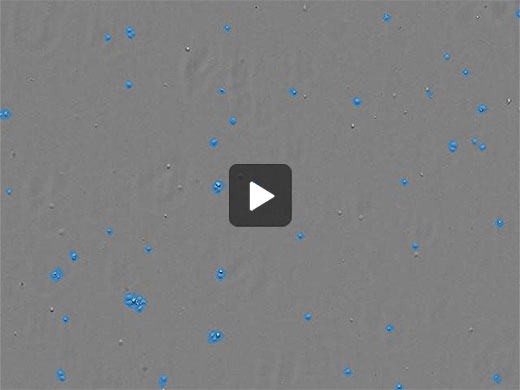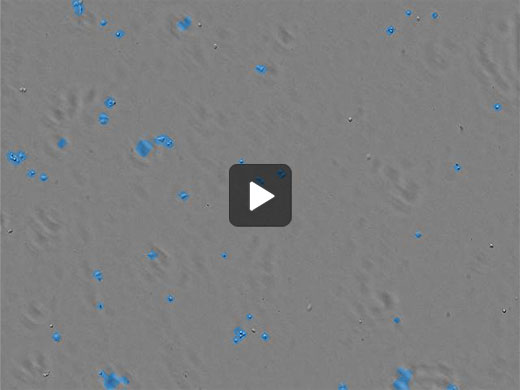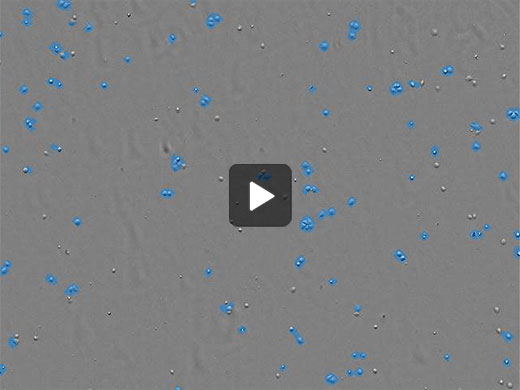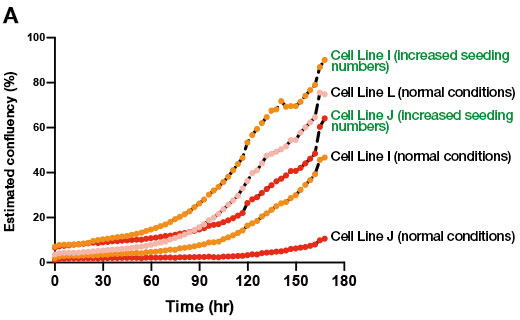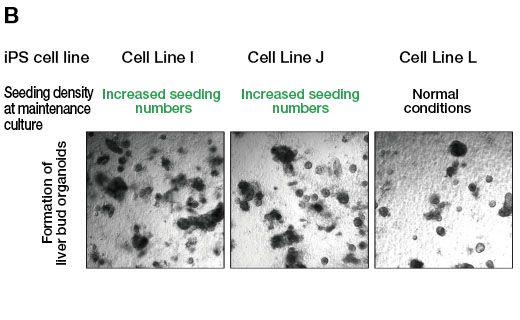Comparing Human iPS Cell Lines using the CM20 Incubation Monitoring System Part 3: Reducing Differentiation Efficiency Variations in Liver Bud Organoids Among iPS Cell Lines
Introduction
Organoids are three-dimensional tissues that can be created from human induced pluripotent stem (iPS) cells in vitro. While the organoids derived from different patients are expected to be studied for functional and individual differences, iPS line-dependent variability limits their applications. The goal of this research is to adopt the CM20 incubation monitoring system to discover the morphometric cues to define donor- and clone-dependence for organoid formation efficiency.
Analyzing the data for each human iPS cell line proliferation acquired by the CM20 monitor
In our initial research, 12 lines of human iPS cells derived from different donors were maintained in an undifferentiated state and monitored using the Olympus CM20 system. Thanks to long-term, quantitative cell status monitoring, we found that specific iPS cell lines show differences in their growth process and instability of their growth speed between passages.
In our next phase of research,we differentiated the 12 human iPS cell lines into liver bud organoids and asked whether there were variabilities in organoid formation and differentiation efficiency among these iPS cell lines. We revealed that the efficiency of subsequent differentiation into organoids is greatly affected by differences in the early stage of proliferation during the maintenance culture, while differences in the doubling time between iPS cell lines did not enable us to judge whether the quality of liver bud organoids formed is good or bad.
To advance this knowledge to improve our methods of liver bud organoid differentiation, we used cell growth data during maintenance cultures that had been acquired from the CM20 monitor in the first phase of our research. We focused on two specific iPS cell lines with low liver bud organoid differentiation efficiency to explore how they behave in different ways from other cell lines. We asked whether it is possible to improve the differentiation efficiency of differentiation-resistant iPS cells by modifying the maintenance culture conditions.
Results
Among the 12 iPS cell lines tested so far, we found that the cell lines I and J are resistant to differentiation into the hepatic lineage. To better understand the reasons, we used a series of images acquired by the CM20 monitor during the early stage of maintenance culture and tried to find differences in the behavior of cell lines I and J by comparing them with iPS cell lines that can efficiently differentiate into the liver lineage.
Interestingly, in the iPS cell lines capable of differentiation (for example, line L), colonies were formed from most of the single cells adhered after passage in the early stage of proliferation. On the other hand, we observed that a higher rate of cell death occurred after adhesion in cell lines I and J, resulting in a significant decrease in colony formation efficiency (Figure 1). This tendency was reproducibly observed over multiple passages. From these observations, we hypothesized that the higher frequency of cell death in the early stages of maintenance culture in differentiation-resistant iPS cell lines causes a lower number of iPS cell colonies, which ultimately decreases their differentiation efficiency into liver bud organoids.
To test this, we increased the number of seeded cells at passage so that the final number of colonies would be equivalent to that of the differentiation-competent iPS cell lines. We then tried to induce the differentiation of liver bud organoids from this culture. We confirmed that increasing the number of seeded cells at passage by about 5 to 10 times resulted in an increase in the number of colonies formed in the differentiation-resistant iPS cell maintenance culture compared to the standard protocol (Figure 2A). In addition, when liver bud organoids were generated from cell lines I and J under these conditions, we obtained sufficient numbers of organoids in contrast to the prior conditions where few organoids were formed (Figure 2B). We also found that these liver bud organoids expressed multiple hepatic markers. These results highlight the utility of CM20 cell culture monitor data to improve the initial stage of differentiation-resistant iPS maintenance cell culture and subsequent differentiation into liver bud organoids.
Cell line I | Cell line J | Cell line L |
Figure 1. Behaviors of human iPS cell lines in the early stages of maintenance culture.
|
Figure 2. Effect of seeding density on organoid formation during the maintenance culture of iPS cells.
(A) CM20 monitoring results of the growth process of 3 human iPS cell lines under normal conditions and maintenance culture under conditions with increased seeding numbers.
(B) The formation of organoids differentiation induction is performed after the maintenance culture of cell lines I and J, showing differentiation resistance under the condition of increasing the number of seeded cells. For comparison, the organoids derived from the L line, a differentiation-competent iPS cell line, is shown when the L line is maintained under standard conditions and then induced to differentiate.
Conclusion
Researchers working with organoids often focus most of their efforts on optimizing the organoid differentiation protocols from iPS cells. When comparing organoids derived from multiple iPS cell lines, most researchers rarely paid attention to their maintenance cultures. This research revealed that the initial state of proliferation during the maintenance culture of iPS cells greatly influences the subsequent differentiation induction efficiency. This suggests that, in addition to developing a protocol for organoid differentiation, the optimization of individual iPS cell maintenance culture protocols is critical to reproducibly generate multiple organoid samples. By using the CM20 monitoring system, which is capable of storing and quantitatively handling longitudinal time series culture data, we can gain new insights and improve our experimental protocols.
Comments from Drs. Takebe and Yoneyama
Dr. Takanori Takebe (left) | One of useful features of the CM20 monitoring system is that we can immediately associate the organoid outcome with the past image stack to evaluate the state of the iPS cells. It was a great asset for our laboratory to be able to inform the conditions during iPS cell maintenance and identify the critical attribute for improving the differentiation efficiency. |
Products related to this application
was successfully added to your bookmarks
Maximum Compare Limit of 5 Items
Please adjust your selection to be no more than 5 items to compare at once
Not Available in Your Country
Sorry, this page is not
available in your country.
